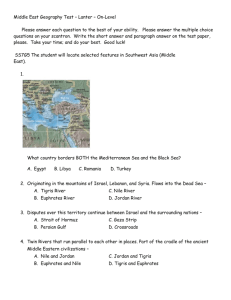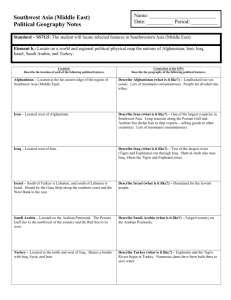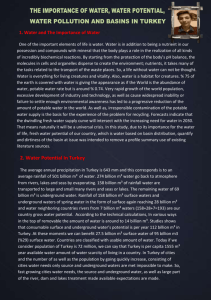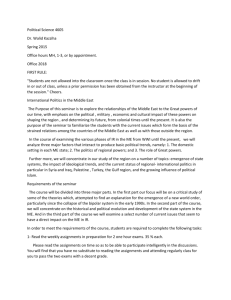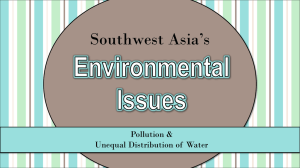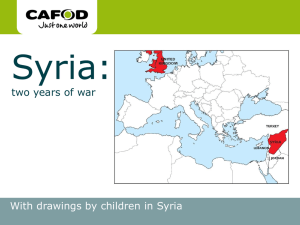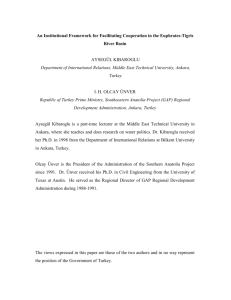from allocating water to sharing baskets of benefits
advertisement
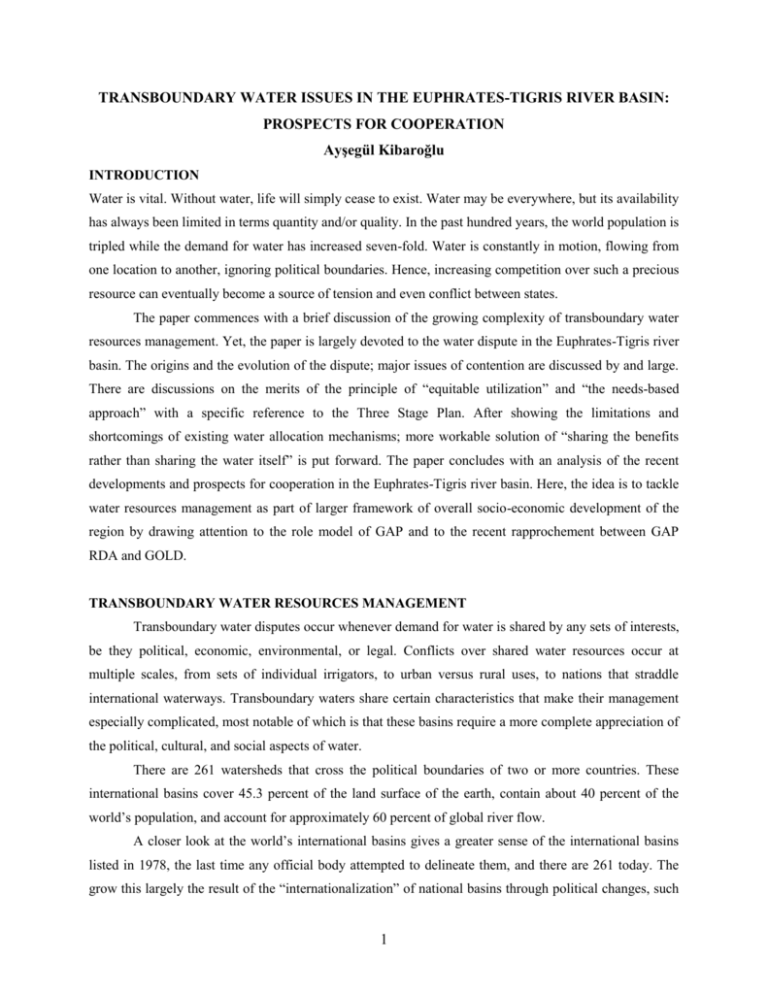
TRANSBOUNDARY WATER ISSUES IN THE EUPHRATES-TIGRIS RIVER BASIN: PROSPECTS FOR COOPERATION Ayşegül Kibaroğlu INTRODUCTION Water is vital. Without water, life will simply cease to exist. Water may be everywhere, but its availability has always been limited in terms quantity and/or quality. In the past hundred years, the world population is tripled while the demand for water has increased seven-fold. Water is constantly in motion, flowing from one location to another, ignoring political boundaries. Hence, increasing competition over such a precious resource can eventually become a source of tension and even conflict between states. The paper commences with a brief discussion of the growing complexity of transboundary water resources management. Yet, the paper is largely devoted to the water dispute in the Euphrates-Tigris river basin. The origins and the evolution of the dispute; major issues of contention are discussed by and large. There are discussions on the merits of the principle of “equitable utilization” and “the needs-based approach” with a specific reference to the Three Stage Plan. After showing the limitations and shortcomings of existing water allocation mechanisms; more workable solution of “sharing the benefits rather than sharing the water itself” is put forward. The paper concludes with an analysis of the recent developments and prospects for cooperation in the Euphrates-Tigris river basin. Here, the idea is to tackle water resources management as part of larger framework of overall socio-economic development of the region by drawing attention to the role model of GAP and to the recent rapprochement between GAP RDA and GOLD. TRANSBOUNDARY WATER RESOURCES MANAGEMENT Transboundary water disputes occur whenever demand for water is shared by any sets of interests, be they political, economic, environmental, or legal. Conflicts over shared water resources occur at multiple scales, from sets of individual irrigators, to urban versus rural uses, to nations that straddle international waterways. Transboundary waters share certain characteristics that make their management especially complicated, most notable of which is that these basins require a more complete appreciation of the political, cultural, and social aspects of water. There are 261 watersheds that cross the political boundaries of two or more countries. These international basins cover 45.3 percent of the land surface of the earth, contain about 40 percent of the world’s population, and account for approximately 60 percent of global river flow. A closer look at the world’s international basins gives a greater sense of the international basins listed in 1978, the last time any official body attempted to delineate them, and there are 261 today. The grow this largely the result of the “internationalization” of national basins through political changes, such 1 as the break up of the Soviet Union and the Balkan states, as well as access to today’s better mapping sources and technology. Even more striking than the total number of basins is a breakdown of each nation’s land surface that falls within these watersheds. A total of 145 nations include territory within international basins. Another way to visualize the dilemmas posed by international water resources is to look at the number of countries sharing each international basin. Nineteen basins are shared by five or more riparian countries: one basin – the Danube – has seventeen riparian nations; five basins – the Congo, Niger, Nile, Rhine, and Zambezi – are shared by between nine and eleven countries; and the remaining thirteen basins – the Amazon, Ganges–Brahmaputra–Meghna, Lake Chad, Tarim, Aral Sea, Jordan, Kura–Araks, Mekong, Tigris–Euphrates, Volga, LaPlata, Neman, and Vistula (Wista) – have between five and eight riparian countries. Disparities between riparian nations – whether in economic development, infrastructural capacity, or political orientation – add further complications to water resources development, institutions, and management. As a consequence, development, treaties, and institutions are regularly seen as, at best, inefficient, often ineffective, and, occasionally, as a new source of tension themselves. Despite the tensions inherent in the international setting, riparians have shown tremendous creativity in approaching regional development, often through preventive diplomacy, and the creation of “baskets of benefits” that allow for positive-sum, integrative allocations of joint gains (Wolf et. al., 2003) THE EUPHRATES-TIGRIS RIVER BASIN The Euphrates and Tigris river systems are often considered as forming one basin because they merge in the Shatt-al-Arab waterway shortly before emptying into the Persian Gulf. Both rivers rise in Turkey and flow through or along Syrian territory before entering Iraq. Turkey occupies the upstream position on both rivers. Almost all the waters of the Euphrates and a large portion of the waters of the Tigris originate within Turkey's borders. The average annual discharge of the Euphrates is 32 billion cubic meters (bcm). Approximately 90 per cent of the water of the Euphrates is generated in Turkey, whereas the remaining 10 per cent originates in Syria. Iraq makes no contribution to the run-off. As for the Tigris and its tributaries, the average annual discharge is 50 bcm. Turkey contributes approximately 40 per cent of the total annual flow, whereas Iraq and Iran contribute 51 per cent and 9 per cent, respectively. No Syrian water drains into the Tigris. The amount of water carried by the Euphrates-Tigris river system can be said to be reasonably sufficient for various uses by the three riparians. However, physical characteristics of the rivers coupled with the initiation of major development projects by the riparians has put exceeding pressures on the supply of the river system. Hence, excessive demand for more water exacerbates tension in the relations of the riparians with each other (Kibaroglu, 1998). 2 Emergence of the Water Dispute among Turkey, Syria and Iraq The relations of three riparians during the period between 1920 and 1960 can be characterized as harmonious. Although planning was done largely on a country by country basis, there were technical consultations among the three states through the early 1960s. None of the countries were engaged in major development projects that could have resulted in excessive consumptive utilization of the Euphrates-Tigris river basin waters. There was, therefore, no exigency during that period in devising a regime framework for better management and utilization of the waters in the basin. Even the inefficient and ineffective development and management practices of the three riparians did not have substantial negative impacts on the quantity and quality of the waters. Populations were at manageable levels, and the rivers’ flows depended only on natural monthly and yearly variations in discharge. The only serious concern of the two downstream riparians was the devastating effect of intermittent flooding (Kibaroglu, 2002). The water question emerged on the regional agenda when the three riparians initiated major development projects. It is only since the 1960s that Turkey and Syria have put forward ambitious plans to develop the waters of the Euphrates-Tigris river system for energy and irrigation purposes. At the same time, Iraq also announced new schemes for an extension of its irrigated area. The uncoordinated nature of these supply-led developments as well as inefficient and ineffective demand management practices within the framework of national water policy and management of the co-riparians continue to be the principal causes of water imbalance in the Euphrates-Tigris river basin. Specifically, the nature of water relations within the last 40 years has been closely shaped by the construction of major development projects, namely the Southeastern Anatolia Project (Turkish acronym GAP) of Turkey, and the Euphrates Valley Project of Syria. In the meantime a series of negotiations have taken place both before construction and after some of the facilities have been put into operation as the result of which several protocols have been signed. Bilateral and Trilateral Negotiations The three riparians entered a new phase of their relationship over water upon the decision by Turkey to construct the Keban dam on the Euphrates. The downstream riparians, particularly Iraq, insisted on guaranteed flows (350 m3/sec at minimum) to be released by Turkey during the impounding period. Hence, a first meeting was held on 22-27 June 1964 with the participation of Turkish and Iraqi experts. The Turkish delegation asserted that it was impossible to reach a single and final formula for the pattern of water to be released from the Keban dam reservoir before impounding by the dam. This pattern, 3 according to the Turkish delegation, depended upon the natural conditions that would prevail during the filling, and on the exact evaluation of the concerned countries’ needs (State Hydraulic Works, 1975). However, under pressure from the donors through an agreement signed with the United States Agency for International Development (USAID), Turkey guaranteed to undertake all necessary measures to maintain a discharge of 350 m3/sec immediately downstream from the dam, provided that the natural flow of the river was adequate to supply the above discharge. This was confirmed orally to Syria and Iraq the same year. Moreover, during this meeting, Turkey proposed to establish a Joint Technical Committee (JTC), which would inspect each river at its source to determine its average yearly discharge. The JTC would determine the irrigation needs of the three countries through joint field studies and would be authorised, by calculating the needs of the riparians for present and future projects, to prepare a statement of main principles and procedures in order to reach an agreement on water rights. A second meeting was held with Syria in Ankara in 1964. During the meeting both delegations exchanged information on the stages achieved in the development of the two major projects: Keban and Tabqa. The Syrian delegation clarified its irrigation targets within the Euphrates Valley Project. The two countries equally emphasised the necessity of having joint meetings with the participation of Turkey, Syria and Iraq. After these bilateral meetings, in accordance with the recommendations of the Turkish delegation, the first tri-partite negotiation was held in Baghdad in 1965. In that meeting the three delegations exchanged technical data with regard to the Haditha, Tabqa and Keban dams. The delegations then moved to discuss the question of setting up a JTC. The Iraqi delegation submitted a draft agreement, which covered, among others, the issue of forming a permanent JTC to be entrusted with supervising the implementation of the agreement. The Turkish delegation strongly rejected the Iraqi draft agreement, and expressed that the JTC could only be authorised to maintain coordination of the current and future projects in the river basin. In line with the Turkish proposal, Syria suggested it would be convenient to include among the functions of the JTC a study of the water requirements of the irrigable lands in the three countries, and subsequently to examine the possibility of covering possible shortages of water supplied by the Euphrates through diverting a part of the Tigris River’s water to the Euphrates. Iraq strongly opposed this proposal and insisted on negotiating only the waters of the Euphrates. During the course of the 1970s, the three delegations gathered on several occasions to exchange information about the technical issues pertaining to the Keban, Tabqa and the Habbaniye reservoirs. No agreement was achieved at the end of numerous technical meetings, and Turkey and Syria went their own ways in determining impounding programmes for the two reservoirs. 4 Joint Technical Committee Meetings The imminent use of the Euphrates and Tigris by Turkey created new demands for cooperation. Because the issues involved in hydropower schemes along the Tigris and Euphrates are so complex and farreaching, the three riparians had to find ways of structuring the dialogue among them. Hence, this time Iraq took the initiative for the formation of a permanent Joint Technical Committee. At the end of the first meeting of the Joint Economic Commission between Turkey and Iraq in 1980, a new JTC was established to discuss and finalise the water issue among the riparians. Syria joined the JTC in 1983 whereupon Turkey, Syria, and Iraq held sixteen meetings up to 1993. The essential mandate given to the JTC was defined as to determining the methods and procedures, which would lead to a definition of the reasonable and appropriate amount of water that each country would need from both rivers. The major items on the agenda of the JTC were the exchange of hydrological and meteorological data and information on the Euphrates-Tigris Basin, the sharing of information on progress achieved in the construction of dams and irrigation schemes in the three riparian countries, and the discussion of initial plans for filling the Karakaya and Atatürk Reservoirs. However, after sixteen meetings, the JTC could not fulfil its objectives and the talks became deadlocked, and failed to produce even outlines of its meetings. Yet, the role of the Joint Technical Committee should not be underestimated. Although its meetings were infrequent and appear to have made little substantive progress on the question of water allocation, it was a useful channel for communication. The major issues that led to the deadlock were related to both the subject and the object of negotiations: whether the Euphrates and the Tigris be considered a single system or whether the discussions could be exclusively limited to the Euphrates. In other words, the final objective of the JTC was to formulate a proposal for the ‘sharing’ of ‘international rivers’, or to achieve a trilateral regime for determining the ‘utilisation of transboundary watercourses’. Iraq and Syria consider the Euphrates an international river that should be treated as an integrated system. Both countries insist on an immediate sharing agreement under which the waters of the Euphrates would be shared on the basis of each country stating its water needs. On the other hand, the Turkish position is that international rivers are only those those constitute a border between two or more riparians. Turkey considers the Euphrates and Tigris as a single transboundary river system, which crosses the common political border. Moreover, Turkey refuses the downstream countries having the rights of co-sovereignty on the waters of the upstream country or vice-versa. Incidents of Water Crises in the Euphrates-Tigris River Basin The Joint Technical Committee meetings did not fulfill the expressed aim of coordinating the development and use patterns of the three riparians. Hence, a number of crises occurred among the 5 riparians during the 1980s and 1990s. A major crisis among the riparians of the Euphrates-Tigris river basin took place during the impounding of the Ataturk dam in Turkey. On 13 January 1990, Turkey temporarily intervened in the flow of the Euphrates river in order to fill the Ataturk reservoir. The decision to fill the reservoir over a period of one month was taken much earlier. Turkey had notified its downstream neighbours by November 1989 of the pending event. In its note, Turkey explained the technical reasons and provided a detailed program for making up for the losses. However, the Syrian and the Iraqi governments protested officially to Turkey, and consequently called for an agreement to share the waters of the Euphrates, as well as a reduction in the impounding period. Another crisis occurred in 1996 after Turkey started the construction of the Birecik, an after-bay dam on the Euphrates river. The dam is designed to regularize the water level of the Euphrates during the generation of hydroelectricity at the Ataturk Dam during peak hours when downstream flow would reach its maximum. Both Syria and Iraq sent official notes to the Turkish government in December 1995 and January 1996 indicating their objection to the construction of the Birecik dam on the grounds that the dam would affect the quantity and quality of waters flowing to Syria and Iraq. HYDROGRAPHY vs. CHRONOLOGY Water development issues must be viewed in an overall context. In conflicts between upstream and downstream users, the scenario at all levels in much the same as in the Euphrates-Tigris river basin: the downstream user generally develops first and is keen to preserve into perpetuity these senior-in time uses. The new user, especially in situations of water scarcity is thus placed in the unenviable situations of justifying the legitimacy of planned measures, which almost certainly will adversely affect the existing uses and raise the potential for conflict. A significant turning point could be reached when focus of the negotiations shifted from the contradictory principles of sovereignty espoused by upstream negotiators and prior use, agreed by downstream states, to that of equitable utilization. Equitable utilization will always be difficult to implement, but it does have the merit of integrating international and national economic processes into a final agreement, thereby enabling a solution that improves the livelihoods of local populations instead of merely focusing on the narrow issue of water deficits. Access to virtual water and in due course, desalinated water will contribute both to economic well-being and to decreasing water scarcity by freeing up scarce freshwater for other nonagricultural purposes. Hence, the equitable and effective management and utilization of transboundary rivers is a key determinant in promoting cooperation in the Euphrates-Tigris river basin. 6 Critics deride the principle of equitable and reasonable utilization as imprecise and incapable of application fail to understand that the real strength of this rule is its flexibility. By its very nature, this principle facilitates the reconciliation of competing interests within a framework adaptable to changing circumstances-economic, environmental and social and other. To develop a methodology to operationalize this principle, possibly in the form of guidelines or a checklist that states could use to compile and assess the information necessary to identify their entitlements, obligations, needs and other relevant factors related to their transboundary watercourse. Forward looking, evolutionary by its nature, the principle of reasonable and equitable utilization, complemented by appropriate procedural rules (i.e. exchange of information, notice, consultation and negotiation, monitoring and compliance mechanisms including dispute settlement) is an inclusive rule that can be effectively applied to assess the legitimacy of water use. By leveling the playing field for all stakeholders and permitting the consideration of all relevant factors, the rule of equitable use is a valuable instrument that servers to prevent adversarial claims of hydrosovereignty. Implementation of the principle encourages an interdisciplinary dialogue inclusive of all stakeholders that is focused on accommodating a range of needs, an approach to be preferred to one that promotes disputes over water rights. FROM RIGHTS TO NEEDS Most international negotiations begin with parties basing their initial positions in terms of rights: the sense that a riparian is entitled to a certain allocation based on hydrography or chronology of use. Upstream riparians often invoke some variation of the Harmon Doctrine, claiming that water rights originate where the water falls. India claimed absolute sovereignty in the early phases of negotiations over the Indus Waters Treaty, as did France in the Lac Lanoux case, and Palestine over the West Bank aquifer. Downstream riparians often claim absolute river integrity, claiming rights to an undisturbed system or, if on an exotic stream, historic rights based on their history of use. Spain insisted on absolute sovereignty regarding the Lac Lanoux project, while Egypt claimed historic rights against first Sudan, and later Ethiopia, on the Nile. In almost all of the disputes that have been resolved, however, particularly on arid or exotic streams, the paradigms used for negotiations have not been ‘rights-based’ at all – neither on relative hydrography nor specifically on chronology of use – but rather “needs-based.” “Needs” are defined by irrigable land, population, or the requirements of a specific project. THE THREE STAGE PLAN The Three-Stage Plan was drafted with a needs-based approach. The Plan encompasses inventory studies of land and water resources of the region to estimate the water needs for the competing sectors in the 7 region, agriculture in particular. The creators of the Plan asserted that by quantifying the needs, the water issue will become more manageable. With the Plan, Turkey calls for the establishment of a joint body for collecting, handling and exchanging data regarding water and land resources so that annual and seasonal variations can be incorporated in the estimations made to determine the allocations. In this respect, data sharing would facilitate the negotiation process and foster the creation of many cooperative structures. Hence, data gathering through joint efforts would enable the riparians to become accustomed to cooperation and to proceed with discussions over water allocations. Along with reaching a set of agreed upon criteria in data-sharing, negotiations could move on to talks on coordination of projects and the creation of joint projects. The Plan is evolutionary and forward-looking in nature, it could be revised according to prevailing conditions and developed further through an interdisciplinary dialogue with the inclusion of the relevant stakeholders. EXISTING WATER USE RULES IN THE EUPHRATES-TIGRIS RIVER BASIN The Protocol of 1987 between Turkey and Syria The Turkish-Syrian Joint Economic Commission meeting on 17 July 1987 had an important outcome regarding the negotiations on the water issue. Hence the first arrangement was the Protocol of Economic Cooperation signed by Turkey and Syria in 1987. The Protocol was not solely devoted to the water issue. It is important to note that the Protocol was regarded as a temporary arrangement. It embodies several articles pertaining to the water issue. The text of Article 6 of the Protocol reads as follows: ‘During the filling up period of the Atatürk dam reservoir and until the final allocation of the waters of Euphrates among the three riparian countries the Turkish side undertakes to release a yearly average of more than 500 m3/sec at the Turkish-Syrian border and in cases where monthly flow falls below the level of 500 m3/sec, the Turkish side agrees to make up the difference during the following month’. Water Allocation Agreement between Syria and Iraq: The Protocol of 1990 Syria and Iraq perceived the interruption to the flow of the Euphrates, due to the impounding of the Atatürk dam, as the beginning of many such interruptions that would be the consequences of envisaged projects within the framework of GAP. Hence, the 13th meeting of the Joint Technical Committee held in Baghdad on 16 April 1990, provided the occasion for a bilateral accord between Syria and Iraq, that is the second arrangement in mention here, according to which 58 percent of the Euphrates waters coming from Turkey would be released to Iraq by Syria. 8 These bilateral accords as interim measures, which were largely products of the then-prevailing political atmosphere in the basin have not served the goal, which was meant to achieve efficient and equitable allocation and management of the water resources in the Euphrates-Tigris river basin. FROM ALLOCATING WATER TO SHARING BASKETS OF BENEFITS One productive approach to the development of transboundary waters has been to examine the benefits in the basin from a regional approach. This has regularly required the riparians to get past looking at water as a commodity to be divided – a zero-sum, rights-based approach – and rather to develop an approach that equitably allocates not the water, but the benefits derived there from: a positive-sum, integrative approach. The boundary waters agreement between the United States and Canada, for example, allocates water according to equal benefits, usually defined by hydropower generation. This result in the seemingly odd arrangement that power may be exported out of basin for gain, but the water itself may not. In the 1964 treaty on the Columbia, an arrangement was worked out whereby the United States paid Canada for the benefits of flood control and Canada was granted rights to divert water between the Columbia and Kootenai for hydropower. Likewise, the 1975 Mekong accord defines “equality of right” not as equal shares of water, but as equal rights to use water on the basis of each riparian’s economic and social needs. These multi resource linkages may offer more opportunities for creative solutions to be generated, allowing for greater economic efficiency through a “basket” of benefits. Energy Resources One increasingly common linkage being made is that between water and energy resources. As noted above, in conjunction with the Mekong Agreement, Thailand helped fund a hydroelectric project in Laos in exchange for a proportion of the power to be generated. In the particularly elaborate 1986 Lesotho Highlands Treaty, South Africa agreed to help finance a hydroelectric/water diversion facility in Lesotho: South Africa acquired rights to drinking water for Johannesburg, and Lesotho receives all of the power generated. Similar arrangements have been suggested in China on the Mekong, Nepal on the Ganges tributaries, and between Syria and Jordan on the Yarmuk. By paying attention only to the issue of water immediately after independence in Central Asia, the international community overlooked opportunities to deepen environmental cooperation and simultaneously foster a situation of regional interdependence and peace. When negotiations focus solely on water sharing, differences between upstream and downstream riparians are reinforced as the gains and losses become very clear. Thus, although cooperation did emerge in Central Asia immediately after 9 independence and violent conflicts over land and water resources have subsided, other forms of discord have appeared that have affected the ability of Central Asian states to share their water resources. These new disagreements involve the exchange of energy resources among the Central asian states. The Soviet legacy of regional economic specialization sheds light on the unique relationship of interdependence between water and energy. Linking sectoral negotiations over resources such as energy and water may provide mutual gains to both upstream and downstream states, reducing uncertainty concerning the fear of defection. Instead of trying to breakdown the interdependencies of the Soviet system, Central asian governments and the international community should seek to build on this legacy of interdependence to realize mutual benefits. However, to mitigate the Aral Sea tragedy at the same time and more imminently, the Central Asian leaderships must also deal with the role of agriculture in the Central Asian economies if they want to attack the root cause of the desiccation of the Aral Sea. For environmental cooperation to bring about a deeper regional peace, a more comprehensive, multisectoral approach is essential. In order to deal with the ecological ills generated by the Aral Sea crisis, the international community must encourage reform in the agricultural sector, with less water intensive crops replacing cotton. Data As water management models become more sophisticated, water data is increasingly vital to management agencies. As such, data itself can be used as a form of negotiating capital. Data-sharing can lead to breakthroughs in negotiations. An engineering study allowed circumvention of an impasse in the Johnston negotiations when it was found that Jordan’s water needs were not as extensive as had been thought, allowing for more room in the bargaining mix. Conversely, the lack of agreed criteria for data in negotiations on the Ganges has hampered progress over the years. Data issues, when managed effectively, can also allow a framework for developing patterns of cooperation in the absence of more contentious issues, particularly water allocations. Perhaps the best example of this internationally is on the Mekong, where the Mekong Committee’s first five-year plan consisted almost entirely of data-gathering projects, effectively both precluding data disputes in the future, and allowing the riparians to get used to cooperation and trust (Wolf, 1999). Broadening the Cooperation Agendas that Enable Links between Cooperation and Development: Focus on Socio-economic Development: water related baskets Desegregation of the issues at stake into relevant categories or baskets expanding the cake by artificially splitting the agreed upon issues. 10 Offering broader agendas to the partners to tackle water resources management as part of larger framework of overall socio-economic development of the river basin (region) thereby showing a new potential framework for water based cooperation. Creation of cooperative frameworks that enable links between cooperation and development More emphasis on equitable usage and socioeconomic development: just hand in hand. Cooperation needs to be grounded in wider development concepts cooperative processes need to be geared to specific goals of development, and poverty reduction related to wider socioeconomic development. GAP: A PARADIGM SHIFT in WATER RESOURCES DEVELOPMENT GAP has been conceived and implemented as a means of integrating water resources development with overall human development in one of the backward regions of Turkey. GAP managers maintain that water resources development is not an end in itself; it is, indeed, a means to an end. The end is to alleviate poverty, improve quality of life, and to maintain the integrity of environment and the ecosystems. GAP, in its historical context, was formulated as a package of water and land resource development project in the 1970s, which was later on transformed, in the early 1980s, to a multisectoral, socioeconomic regional development program, and then into a sustainable human development project in the 1990s. As the GAP has shifted over the years from an infrastructure development project, into a project that coordinates social, cultural, economic and environmental efforts, its changes have followed the changes in global thinking about development. In the last decade, international conferences such as the Earth Summit (Rio, 1992), and the WSSD (Johannesburg, 2002) have put forward ideas about sustainability, gender equity, encouraging grassroots involvement, protecting the environment and so on. WEHAB initiative of the UN Secretary General seeks to provide focus and impetus to action in the five key thematic areas of water, energy, health, agriculture and biodiversity that are integral to a coherent international approach to the implementation of sustainable development. GAP managers have applied these principles of sustainable development to a variety of activities ranging from marketing studies for new agricultural products to establishing women’s community centers in poor neighborhoods. In the field of water development, management and use, the three countries in mention can exploit the potential areas for cooperation by benefiting from the experience and practices of one another, develop these into common practice. 11 RECENT DEVELOPMENTS and PROSPECTS FOR COOPERATION IN THE EUPHRATESTIGRIS RIVER BASIN The signing of the Adana Accords in 1998 provided the basis for the concerned authorities in both countries to expand their relations to other fields like economic, commercial, scientific and technical cooperation. Hence, the GAP-RDA (www.gap.gov.tr) took some useful steps last year to initiate contacts with Syria by sending a delegation to that country following the invitation of the General Organisation for Land Development (GOLD), Ministry of Irrigation, Syria. Following this mission, a Syrian delegation headed by the Minister of Irrigation paid a visit to Turkey. As a result of these bilateral relations, a Joint Communiqué was signed between the GOLD and the GAP Administration on 23 August 2001. This agreement envisions the cooperation of the two sides in such areas as training, study missions, technology exchange and conduct of joint projects. The agreement intends to improve the relations between the two countries further, through training of staff from both countries, by hosting specialists from Syria in Turkey specific training activities. If such training is institutionalised, courses are planned to be organised either in Syria or in Turkey for other Arab speaking countries as well. In fact, steps have already been taken, and a technical team from Syria has been invited to the region to discuss the principles of implementation. This agreement between GAP and GOLD also includes provisions about ‘twin protection areas’-one from each country to be studied, planned and implemented as a Twin Development Project that can be implemented in both countries. Moreover, an implementation document was signed in June 2002 to define the principles of implementation of the cooperation envisioned in the Joint Communiqué. This document defines the projects, training programs, and activities to be conducted between the parties. These networks can offer broader agendas to the parties to tackle water resources management as part of larger framework of overall socio-economic development of the river basin (region), thereby showing a new potential framework for water based cooperation. The overall goal of this agreement and its subsequent implementation protocol (2002) is to provide sustainable utilisation of the region’s land and water resources and to deal with water management within a larger picture of overall socio-economic development and integration of the under developed regions in Turkey and Syria. Under this recent promising developments between Turkey and Syria, GAP, which once constituted only a bone of contention in the regional politics, is becoming a source of gradual cooperation for development related activities. 12 The agreement is majorly drafted with a basic objective of establishing a joint dialogue between the two countries to open up new opportunities for realizing win-win solutions. REFERENCES Wolf, Aaron T., Shira B. Yoffe, and Mark Giordano. 2003. International waters: identifying basins at risk. Water Policy, 5(1):29-60. Wolf, A. 1999. Criteria for Equitable Allocations: The Heart of International Water Conflict. Natural Resources Forum 23(1) 3-30. Kibaroğlu, A. 2002. Building a Regime for the Waters of the Euphrates-Tigris River Basin, Kluwer Law International, London, The Hague, New York. Kibaroğlu, A. and O. Unver "An Institutional Framework for Facilitating Cooperation in the Euphrates-Tigris River Basin,", International Negotiation: A Journal of Theory and Practice, Dordrecht, The Netherlands, Vol. 5, No. 2, 2000, pp. 311 - 330 www.gap.gov.tr 13
